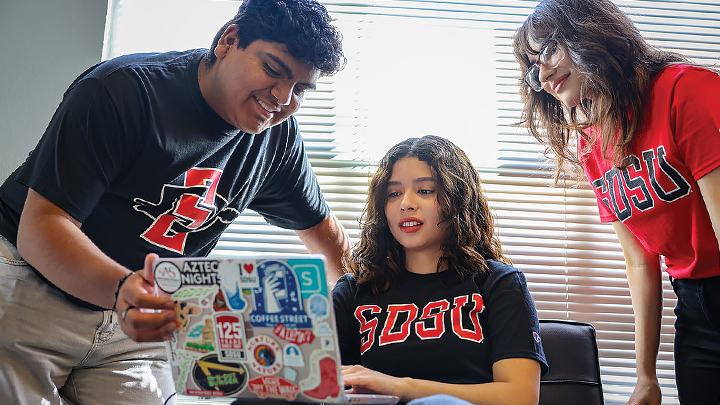Enhancing organizational relationships through shared services is a key element of the SDSU Strategic Plan, as defined in Activity 12 as “Identifying areas to advance synergies for shared services across campus units for improved efficiency and accountability.”
Toward that goal, and others interconnected in the strategic plan, the Information Technology Division was established in July 2019 by combining Enterprise Technology Services, Instructional Technology Services, Enrollment Services Information Technology and Business Information Systems.
At the charge of SDSU President Adela de la Torre, and driven by the We Rise We Defy: Transcending Borders, Transforming Lives strategic plan, information technology has evolved from a fragmented, decentralized function into what is now the Information Technology Division and OneIT Community. Within recent years, IT-related units have been consolidated and led by the Vice President for Information Technology and Chief Information Officer (CIO).
The creation of this unified OneIT Community is increasing efficiency and collaboration across IT personnel. This includes prioritizing funding to support mission critical resources, such as the SDSU Data Center. Establishing the OneIT Community also made possible the consolidation of help-desk support across all colleges and IT units through the implementation of the ServiceNow service management tool. These enhancements resulted in more reliable and consistent information technology governance, infrastructure, access, and support.
In addition to unifying information technology professionals campuswide to offer more structured and timely support for campuswide needs, the division has introduced numerous new initiatives, training institutes and other resources to directly benefit the work of faculty, staff and students.
“In recent years, and certainly during the pandemic, colleges and universities have had to be prepared for unprecedented change. Indeed, we have had to rethink how we teach,” said James Frazee, interim vice president for Information Technology and Chief Information Officer
“Within the Information Technology Division, and informed by the strategic plan, our teams have worked quickly to develop flexible, customizable, technology-enhanced learning opportunities,” Frazee said. “This has allowed our university to be nimble and to adjust quickly and responsibly, allowing our faculty to learn new technologies and ways of teaching that meet the needs of today’s learners.”
Integrated IT Initiatives
Either as a direct activity embedded by the We Rise We Defy: Transcending Borders, Transforming Lives strategic plan, or developed as an activity motivated by the strategic plan, the Information Technology Division has:
- Aligned the work of Instructional Technology Services (ITS) with SDSU’s strategic plan and California State University system’s Graduation Initiative 2025.
- Launched the OneIT Community initiative to coordinate efforts to improve SDSU’s IT infrastructure and services.
- The Information Technology Division broke down silos in Desktop Support, HelpDesk, College IT, and User Services. This has led to a more streamlined and efficient service delivery model, resulting in quicker resolution of IT issues and improved user experience.
- With a single point of contact for all IT support needs, students, faculty and staff, no longer have to navigate through complex and confusing support structures.
- The new OneIT Help Desk provides a unified and consistent support experience, regardless of the type of issue or the end user involved.
- Unifying service and support on campus has increased collaboration and transparency. By breaking down silos and promoting cross-functional teamwork, the OneIT Helpdesk is fostering a culture of trust and knowledge sharing. This will lead to better problem-solving, more innovation, and a stronger sense of community.
- Launched my.SDSU student information system, which now provides a centralized gateway for the critical systems that SDSU students use on a daily basis. The project was designed to: provide better service, accessibility (mobile friendly) and security; align vendor solution software with the other CSU campuses, enabling faster reporting and bringing us into compliance with basic requirements of the Chancellor’s Office and WASC recommendations; enable SDSU to more readily adopt and support other third party offerings that offer integration back to my.SDSU; and consolidate the user experience for financial aid, academic records, class schedule, profile changes to personal information, and student billing and payment activities into one centralized system with one consistent and secure login for students.
- Established the Cybersecurity Center for Academic Excellence, a research center that will serve as a platform to conduct research on a range of existing and emerging cybersecurity issues.
- Created the AI Faculty and Student Fellows to explore opportunities related to generative AI (gAI).
- Launched the Academic Applications of AI (AAAI) micro-credential program for instructors to train faculty how to creatively and responsibly use gAI in their teaching and research. Registration is available online.
- Led, in coordination with Strategic Communications and Public Affairs (StratComm) a web alignment initiative migrating campus web priorities off of outdated and vulnerable systems onto a centralized content management system.
For example: In response to students’ interest in more active learning and the shift to virtual instruction during the COVID-19 pandemic, the Information Technology Division launched the Flexible Course Design Institute. Today, more than 1,100 instructors have been trained in new teaching strategies and in how to use learner-centered technologies.
“Once seen as a secondary option, online learning has taken on more of a primary role at SDSU,” Frazee said, adding that the university is offering more online, and distributed learning opportunities through our Global Campus.
The IT Division also launched the Virtual Immersive Teaching and Learning (VITaL) Research Center to serve as an incubator for promoting experimentation with curriculum design and the scholarship of teaching and learning.
“We are responding to the reality that virtual and augmented reality is changing the ways people work and learn,” said Sean Hauze, the Instructional Technology Services director.
“We are providing opportunities for students to explore and understand through simulated scenarios what it will be like to perform surgeries, explore the cosmos, practice art concepts and more – all through a digital interface,” said Hauze. “These emergent technologies are essential in allowing us to teach our diverse population of learners in ways that are creative, affordable and that meet discipline-specific training needs.”
Also related to supporting teaching and learning, the IT Division introduced Empathy Lens to leverage eXtended Reality (XR) technology to help people learn more about themselves and to better understand others. Through integrated media, storytelling and virtual immersive experiences, the project helps campus community members to broaden their perceptions of others while learning about topics such as homelessness, healthcare, individuals with disabilities, consumer relations and group dynamics, among other topics.
“Through our strategic plan, there is a natural convergence that is happening on our campus with a focus on unifying and strengthening our IT infrastructure and also adopting new technologies for teaching and learning,” Frazee said. “This is a period of intense innovation that will forever change the nature of how we teach, how our students learn and how our faculty create and invent.”





